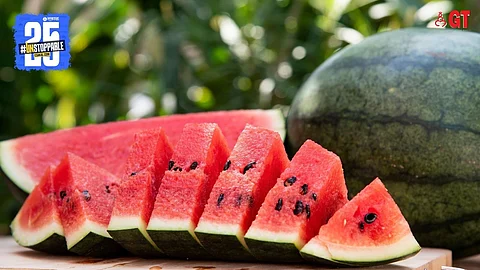

The Goa College of Home Science, Campal, Panjim is celebrating the happiness of inclusivity that was referred to as a challenge until recently, and a handicap before that. Journalist and champion of inclusivity (differently-abled, not disabled), Prakash Kamat, is bringing the prophetic words of the Lebanese-American poet, Khalil Gibran, to life.
The students of the Home Science College and the Goa College of Agriculture, Ela Farm, are as busy as honey bees preparing to pollinate these ideas and bring forth sweet fruit.
Like the watermelon, such fruits are the result of repeated pollination. Goa's Festakar, Marius Fernandes, is playing the role of the Queen Bee, and this is his 99th Fest.
NOTES ON WATERMELONS
The watermelon is the choice fruit of the summer season. In a short span of two to two and half months from sowing, watermelons are ready for harvest. The size of the melon depends on the variety, the quality of seed, the fertility of the soil, the regulation of the water and repeated pollination by bees.
The more the number of seeds, the bigger is the fruit in the traditional watermelon varieties. The seeds produce both, the growth hormones and the ripening hormones. In the ‘seedless’ varieties these have to be supplied externally as in the case of seedless grapes. There is a price to be paid for convenience.
Similarly, it is easy to present an event with professional artistes. However, training the youth, especially students, to perform and present an event needs repeated rehearsals. But, it is well worth the effort because it not only prepares the students for an event but for life.
The skills learnt are like seeds that will germinate and produce new plants, not just a bigger fruit in the form of an event.
Good seeds give rise to good plants and skilled students become entrepreneurs and create opportunities for others to join in and grow.
The ‘fests’, over a quarter of a century, have spawned other community markets and events that function on their own in each village. They have also brought the Goa government’s notification of the ghumot as the ‘folk musical instrument of Goa’ without monitor lizard hide.
A watermelon that looks beautiful is not necessarily the one you will enjoy eating. The creamy or yellow, discoloured patch indicates that the watermelon was ripe when harvested. What one believes is a defect is actually an indicator that the fruit is good.
The creamy or yellow, discoloured patch indicates that the watermelon was ripe when harvested. What one believes is a defect is actually an indicator that the fruit is good.
Those bees are not pests; they help in the pollination of watermelons and also give us valuable honey.
The Goa College of Agriculture, at Ela Farm in Old Goa, will celebrate honey on Saturday, April 12, 2025. The events are open to the public, and those interested in agriculture or honey, can benefit by attending the event.
Watermelon cultivation has become profitable in the former mining heartland of Dharbandora, Codli, Nirankal, where buzzing honeybees have largely replaced mining trucks.
Varad Nagesh Samant is now a major watermelon grower in that area, which has produced a number of ‘Krishi Ratna’ awardees ever since the mining slowdown in 2011-12.
Others like Gaspar Fernandes, from Anjuna, have joined the Parra watermelon growers in earning good money from the crop, silencing the critics who say that agriculture is not economical, despite more and more farmers turning to rice cultivation.
(The author is the former Chairman of the GCCI Agriculture Committee, CEO of Planter's Choice Pvt Ltd, Additional Director of OFAI and Garden Superintendent of Goa University, and has edited 18 books for Goa & Konkan).